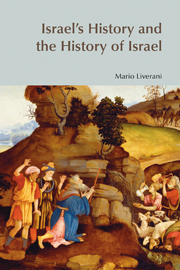Book contents
- Frontmatter
- Dedication
- Contents
- List of Tables and Illustrations
- Foreword
- Abbreviations
- IMPRINTING
- Part I A NORMAL HISTORY
- Chapter 2 THE TRANSITION (TWELFTH CENTURY)
- Chapter 3 THE NEW SOCIETY (c. 1150–1050)
- Chapter 4 THE FORMATIVE PROCESS (c. 1050–930)
- Chapter 5 THE KINGDOM OF ISRAEL (c. 930–740)
- Chapter 6 THE KINGDOM OF JUDAH (c. 930–720)
- Chapter 7 THE IMPACT OF THE ASSYRIAN EMPIRE (c. 740–640)
- Chapter 8 PAUSE BETWEEN TWO EMPIRES (c. 640–610)
- Chapter 9 THE IMPACT OF THE BABYLONIAN EMPIRE (c. 610–585)
- INTERMEZZO
- Part II AN INVENTED HISTORY
- EPILOGUE
- Bibliography
- Index of References
- Index of Names of Persons and Deities
- Index of Placenames
Chapter 6 - THE KINGDOM OF JUDAH (c. 930–720)
from Part I - A NORMAL HISTORY
- Frontmatter
- Dedication
- Contents
- List of Tables and Illustrations
- Foreword
- Abbreviations
- IMPRINTING
- Part I A NORMAL HISTORY
- Chapter 2 THE TRANSITION (TWELFTH CENTURY)
- Chapter 3 THE NEW SOCIETY (c. 1150–1050)
- Chapter 4 THE FORMATIVE PROCESS (c. 1050–930)
- Chapter 5 THE KINGDOM OF ISRAEL (c. 930–740)
- Chapter 6 THE KINGDOM OF JUDAH (c. 930–720)
- Chapter 7 THE IMPACT OF THE ASSYRIAN EMPIRE (c. 740–640)
- Chapter 8 PAUSE BETWEEN TWO EMPIRES (c. 640–610)
- Chapter 9 THE IMPACT OF THE BABYLONIAN EMPIRE (c. 610–585)
- INTERMEZZO
- Part II AN INVENTED HISTORY
- EPILOGUE
- Bibliography
- Index of References
- Index of Names of Persons and Deities
- Index of Placenames
Summary
The ‘House of David’
On the death of Solomon, the kingdom of Judah lost the support of Ephraim, and was restricted to the territories of Judah and Benjamin, the latter being the object of border disputes with Israel. The list of fortresses (or fortified cities) said to have been built by Rehoboam (2 Chron. 11.5–12; Kings does not mention them) is probably to be dated to Hezekiah's time (cf. §7.4). Rehoboam (931–913) also had to suffer the consequences of the campaign of the Egyptian army of Sheshonq directed at the north: he paid tribute, taking money from the treasures of the temple. (Since such a necessity recurred, it should be made clear that the ‘Solomonic’ temple was actually an annexe of the royal palace, having no independence: economically, it functioned as the treasury of the royal palace.)
The wars against Israel continued during the reigns of Abijam (913–911) and Asa (911–870), and Asa had to press for military intervention by Ben-Hadad, king of Damascus, to avoid submission to Israel:
‘Let there be an alliance between me and you, like that between my father and your father: I am sending you a present of silver and gold; go, break your alliance with King Baasha of Israel, so that he may withdraw from me’
(1 Kgs 15.19).- Type
- Chapter
- Information
- Israel's History and the History of Israel , pp. 128 - 142Publisher: Acumen PublishingPrint publication year: 2005

